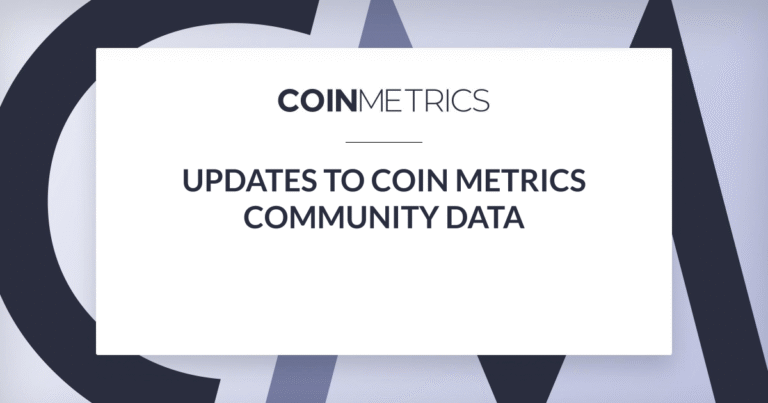Coin Metrics is pleased to share some important updates regarding Ethereum’s upcoming protocol consensus change, commonly referred to as the Merge. The Merge is widely considered to be one of the most highly-anticipated events in crypto history, and will introduce several major changes to the underlying infrastructure of the Ethereum blockchain.
Over the next several weeks, we will be sharing a series of announcements that will outline our approach to supporting this protocol upgrade. These announcements will include educational materials, product feature enhancements, and API specifications related to the blockchain’s transition to Proof of Stake.
The timeline for the Merge is potentially subject to change, but the most important protocol updates are currently expected to occur on September 6th and September 15th.
What is the Merge? Over the last two years, the Ethereum network has been working towards a major upgrade to shift away from the existing Proof of Work (PoW) consensus mechanism towards Proof of Stake (PoS). With this change, transaction validation will transition from a more energy-intensive “mining” process to a collateral-based validation process known as “staking.”
As a first step in this transition, in December 2020 the Ethereum developer team introduced the Beacon Chain, a parallel Proof of Stake blockchain now referred to as Ethereum’s “Consensus Layer.” As the name implies, this layer will ultimately be used to reach consensus in the validation of new blocks and transactions. After the Merge, the network’s core application layer (known as the “Execution Layer”) will cease using Proof of Work consensus and switch to Proof of Stake consensus, orchestrated by the Beacon Chain.
The good news is that this change will have minimal impact on day-to-day users of the network. Generally speaking, there will be no major changes to how most Ethereum-based applications function— blocks, transactions, and transfers will continue to work the same way they have since the protocol’s inception.
Are there any risks? The Merge has been simulated on multiple Ethereum testnets, most recently on the Goerli testnet in August. During the majority of these testnet transitions, disruptions to network uptime and functionality were relatively limited. From the perspective of the Ethereum core development team, these test runs have been successful enough to push forward with the planned Merge timeline.
That being said, there are likely still many “unknown unknowns” that could lead to unexpected network disruptions through the course of the mainnet transition to Proof of Stake. The Ethereum ecosystem is comprised of highly complex, interdependent software applications. While the majority of stakeholders have spent many months diligently preparing for this event, unforeseen circumstances could still arise.
As a result, Coin Metrics is taking great care to monitor and respond to any unexpected issues with mission-critical services dependent on our Ethereum market data pipelines and node infrastructure. Listed below are a few key focus areas for our team.
Research
The Coin Metrics Research team has been working on several research reports to inform our community on all angles of the Merge, covering everything from technical basics, to market impacts, to the new economics of the Consensus Layer. On Tuesday, we plan to release the first research report in this series, breaking down the most important moving parts of The Merge and its implications for the future of Ethereum.
Network Data
Coin Metrics has been supporting on-chain Ethereum data since the network’s genesis, and will be continuing coverage of the existing Execution Layer, in addition to extending our coverage to the new Consensus Layer. We will be introducing this coverage under a new network data symbol where we will be releasing new metrics around staking and activity on the Consensus Layer. Our new metrics will give valuable insight into staking supply and validators along with interactions between the Execution and Consensus Layers.
In coming weeks, we will share more details on which Proof of Work metrics in our Farum and Network Data products will no longer be calculated. Additionally, we will be updating the definitions of metrics so insights into legacy miner activity can still be analyzed on Ethereum. As always, our team is committed to growing our coverage of this expanding ecosystem, providing our clients and community members the best possible view into this on-chain data.
Coin Metrics goes through a careful process when evaluating whether to support a new blockchain network. Alternative networks may emerge during Ethereum’s shift to Proof of Stake, and our team will be carefully monitoring network activity to determine whether any forks have enough viability to warrant coverage in our Network Data and ATLAS product offerings.
Market Data
Coin Metrics harmonizes all market data we collect from exchanges by converting exchange-reported symbols to a set of Coin Metrics harmonized asset tickers. Coin Metrics strives to follow the most widely adopted market convention in assigning our tickers.
With such a dramatic change to the network, there is a high likelihood that certain entities may attempt to “hard fork” the Ethereum blockchain, creating a separate network with a shared transaction history. Several exchanges have already announced their intention to support a potential Proof of Work version of Ethereum, if one persists even after the main chain’s transition to Proof of Stake.
As the Ethereum hard fork approaches, Coin Metrics will closely monitor the announcements of all exchanges and other major market participants regarding which tickers they will use for an ETH Proof of Stake asset and ETH Proof of Work asset. When a market convention emerges, Coin Metrics will make the appropriate ticker harmonization changes so that all data for a particular asset will be served under one ticker, regardless of the ticker conventions of specific exchanges.
The introduction of the Consensus Layer will have new impacts to the market with speculation around possible ETH Proof of Work forks. In the event that an ETH Proof of Work asset exists and a market convention is established, Coin Metrics plans to rapidly support a reference rate and other market metrics for this new asset. Our reference rates and pricing mechanisms will monitor any important markets that may emerge.
Indexes
Coin Metrics has been calculating Ethereum-based indexes through Coin Metrics Bletchley Indexes (CMBI) since 2020. In all instances, we strive to abide by strict governance protocols through our methodologies. With the Ethereum Merge quickly approaching, CMBI is monitoring market and network data to determine when a market convention is reached. If a contentious hard fork occurs, CMBI will follow our Fork Legitimacy Policy to decide whether a viable fork has occurred, and whether our total return indexes should be credited.
How can you stay updated? In the coming weeks, Coin Metrics will be closely monitoring the events surrounding the Merge and will be publishing several rounds of client communication to ensure you know what to expect. This will include in-depth research and preemptive notices on changes to existing metrics, as well as more detail on the new Consensus Layer metrics. In addition to Email and Slack, you can keep updated through the following channels:



